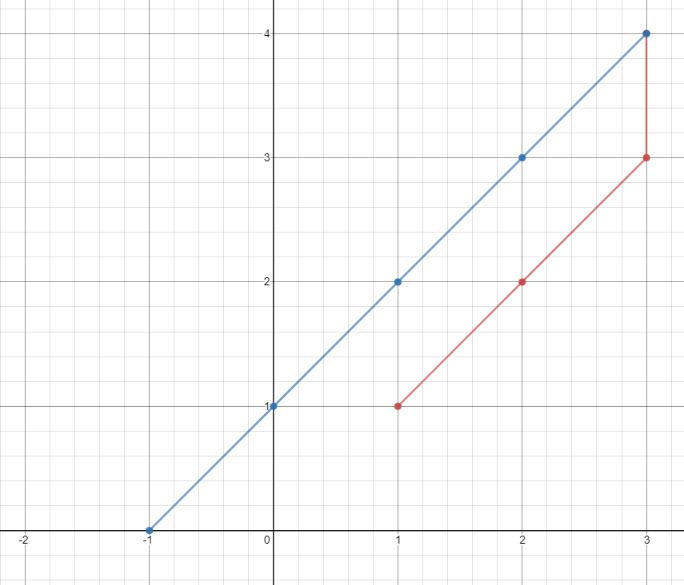- {x}
- Synonymous Sentences
- Handshakes That Don't Cross
- Shift 2D Grid
- Find Elements in a Contaminated Binary Tree
- Greatest Sum Divisible by Three
- Minimum Moves to Move a Box to Their Target Location
- Page Recommendations
- Print Immutable Linked List in Reverse
- Minimum Time Visiting All Points
- Count Servers that Communicate
- Search Suggestions System
- Number of Ways to Stay in the Same Place After Some Steps
- All People Report to the Given Manager
- Hexspeak
- Remove Interval
- Delete Tree Nodes
- Number of Ships in a Rectangle
- Read More...

Minimum Time Visiting All Points
On a 2D plane, there are n points with integer coordinates points[i] = [xi, yi]. Return the minimum time in seconds to visit all the points in the order given by points.
You can move according to these rules:
- In
1second, you can either:- move vertically by one unit,
- move horizontally by one unit, or
- move diagonally
sqrt(2)units (in other words, move one unit vertically then one unit horizontally in1second).
- You have to visit the points in the same order as they appear in the array.
- You are allowed to pass through points that appear later in the order, but these do not count as visits.
Example 1:

Input: points = [[1,1],[3,4],[-1,0]] Output: 7 Explanation: One optimal path is [1,1] -> [2,2] -> [3,3] -> [3,4] -> [2,3] -> [1,2] -> [0,1] -> [-1,0] Time from [1,1] to [3,4] = 3 seconds Time from [3,4] to [-1,0] = 4 seconds Total time = 7 seconds
Example 2:
Input: points = [[3,2],[-2,2]] Output: 5
Constraints:
points.length == n1 <= n <= 100points[i].length == 2-1000 <= points[i][0], points[i][1] <= 1000
Minimum Time Visiting All Points
This problem involves finding the minimum time to visit a series of points in a 2D plane, given constraints on movement. We can move one unit vertically, one unit horizontally, or diagonally (one unit in each direction) in one second.
Approach
The key insight is that the minimum time to travel between two points (x1, y1) and (x2, y2) is the maximum of the absolute differences in their x and y coordinates: max(|x2 - x1|, |y2 - y1|). This is because we can always choose a path that uses diagonal moves as much as possible to minimize the time.
The solution iterates through the pairs of consecutive points, calculates the minimum time to travel between each pair using the formula above, and sums up these times.
Time and Space Complexity
- Time Complexity: O(n), where n is the number of points. We iterate through the points once.
- Space Complexity: O(1). The algorithm uses a constant amount of extra space.
Code Implementation (Python)
from itertools import pairwise
class Solution:
def minTimeToVisitAllPoints(self, points: list[list[int]]) -> int:
total_time = 0
for (x1, y1), (x2, y2) in pairwise(points):
total_time += max(abs(x2 - x1), abs(y2 - y1))
return total_time
The pairwise function from the itertools library efficiently generates pairs of consecutive elements in the list of points. This makes the code cleaner and more readable. If itertools isn't available (e.g., in some restricted coding environments), a manual loop can be used as demonstrated in the other language examples.
Code Implementation (Other Languages)
The same core logic is implemented in other languages below, demonstrating the adaptability of this approach:
Java:
class Solution {
public int minTimeToVisitAllPoints(int[][] points) {
int totalTime = 0;
for (int i = 1; i < points.length; i++) {
int dx = Math.abs(points[i][0] - points[i - 1][0]);
int dy = Math.abs(points[i][1] - points[i - 1][1]);
totalTime += Math.max(dx, dy);
}
return totalTime;
}
}C++:
class Solution {
public:
int minTimeToVisitAllPoints(vector<vector<int>>& points) {
int totalTime = 0;
for (size_t i = 1; i < points.size(); ++i) {
int dx = abs(points[i][0] - points[i - 1][0]);
int dy = abs(points[i][1] - points[i - 1][1]);
totalTime += max(dx, dy);
}
return totalTime;
}
};JavaScript:
/**
* @param {number[][]} points
* @return {number}
*/
var minTimeToVisitAllPoints = function(points) {
let totalTime = 0;
for (let i = 1; i < points.length; i++) {
let dx = Math.abs(points[i][0] - points[i-1][0]);
let dy = Math.abs(points[i][1] - points[i-1][1]);
totalTime += Math.max(dx, dy);
}
return totalTime;
};These examples all follow the same efficient O(n) time and O(1) space algorithm. The only variation is the syntax specific to each programming language.